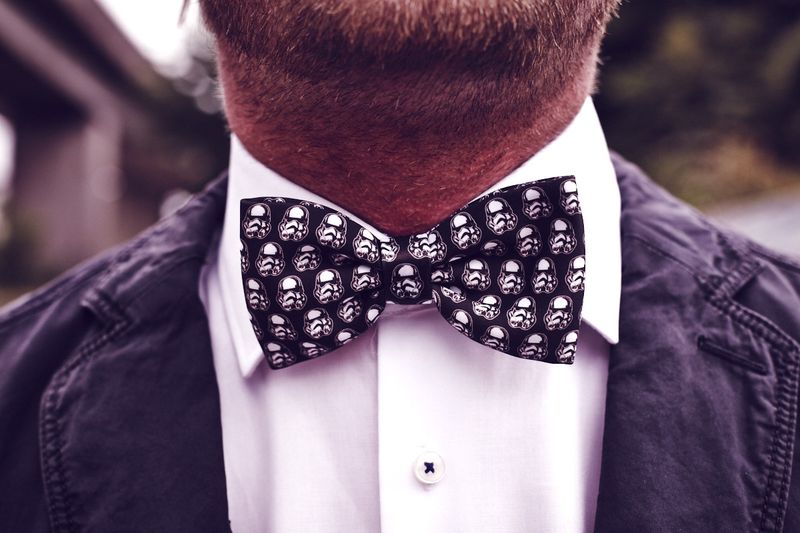
Customer experience in Apparel & Accessories differs from any other retail segment. In this segment, the key role in the purchase decision is given to factors that may be insignificant in other product categories. For instance, size – the customer is shopping for products of a particular size. Individual brand preferences – the customer first tries to find an option within their favorite brands, before moving to any other. Gender – 99% of the time a woman will shop for products for women.
A quick comparison with any other category, for example, smartphones: an iPhone 7 will fit well in both women’s and men’s hands, regardless of their height or body type. An entirely different set of factors influences the purchase decision in this category.
What does this mean for a retail Apparel & Accessories company? Product personalization must rely on the key parameters relevant to each customer and prospect; the size (clothing and shoe), gender, brand preferences. Very often, online retail companies make a blunt mistake ignoring these key parameters in their personalization.
In this special post, we analyzed different retail Apparel & Accessories companies’ experience. You will understand their mistakes from our visual examples. Learn why Big Data-based personalization fails to deliver any tangible results, whereas a Progressive Personalization-driven approach leads to a solid rise in conversion, ARPU, and AOV.
Incorrect Approach to Personalization
Gender
One of the biggest mistakes is ignoring the visitor’s gender.
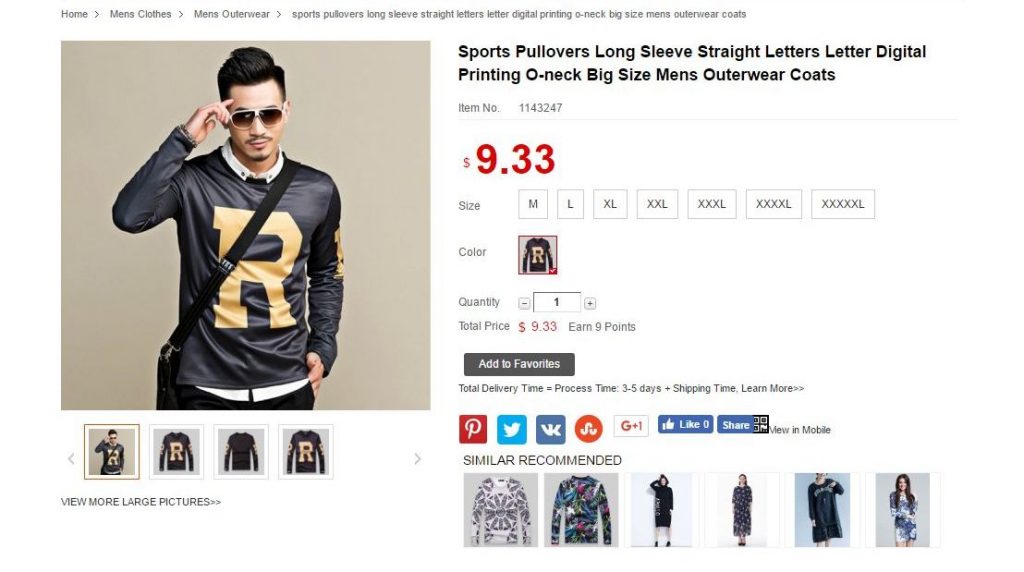
Chinese online retailer Wholesale Clothes Mart includes women’s clothes in recommendations even on the product pages in the “Men’s Clothes” category. Quite odd logic isn’t it?
Even if you are persistent enough to browse their product catalog for hours, you will never see any difference.
This type of incorrect personalization leads to almost 0% conversion for products recommended to the male section of their audience (except, maybe, men who aim to buy a gift for their spouse).
Size
The second big mistake is ignoring the visitor’s size.
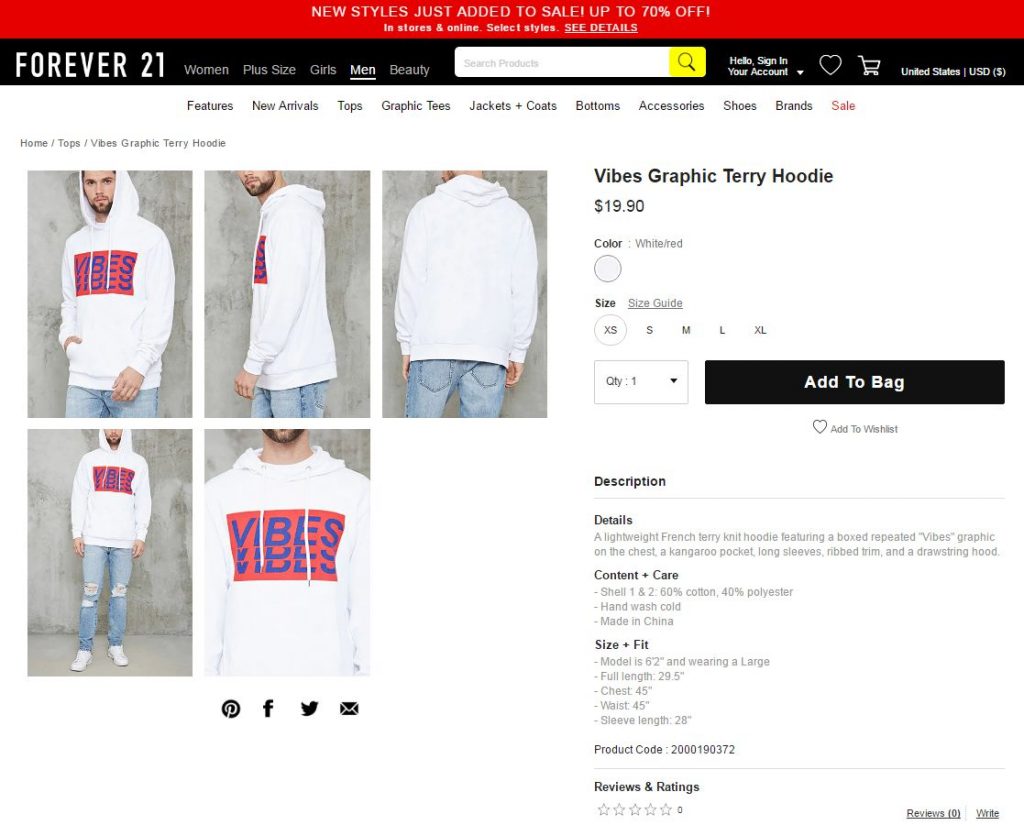
Choosing a certain product size (e.g. XS) at Forever 21 and even putting it in the Shopping Cart won’t change anything in their product recommendations.
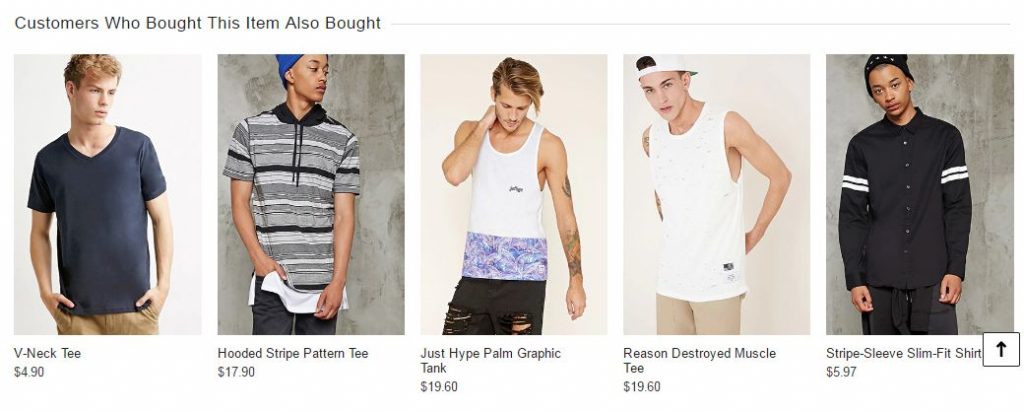
The recommendation block filters products by the gender – all the products above are for men.
Let us see how much selling potential these product recommendations hold. A click on a recommended item brings us to the product detail page only to show that it is only available in XL size:
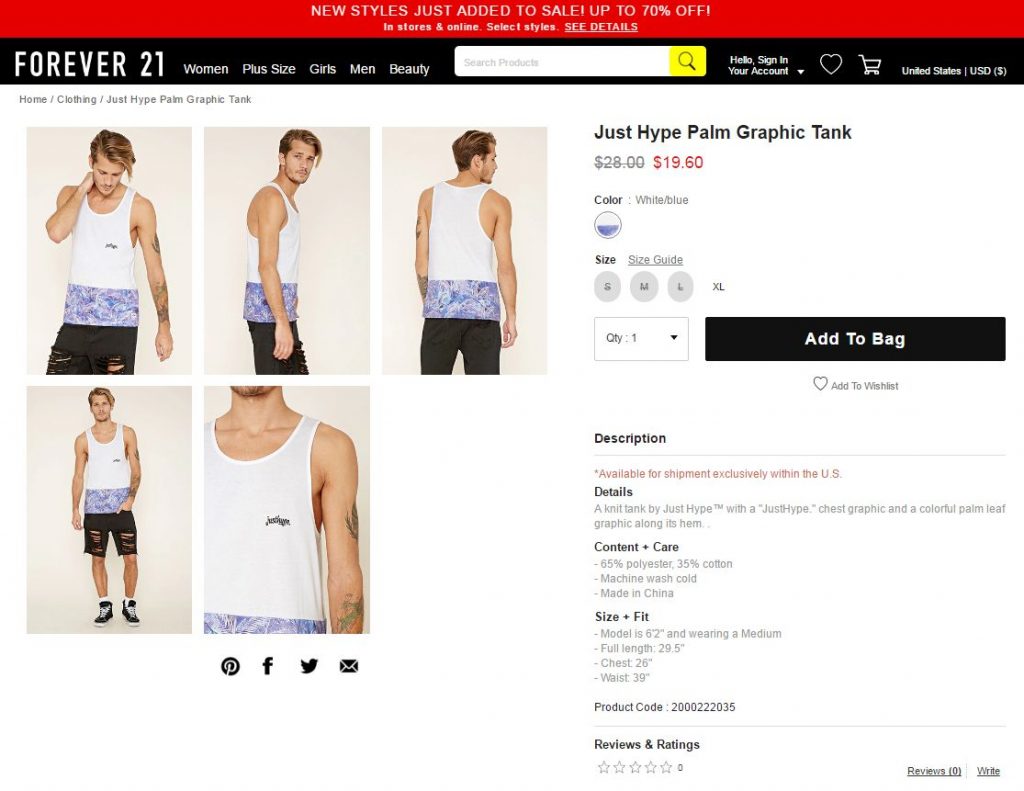
There are no other sizes in stock but XL, whereas XS was specifically chosen for the initial product as the target size.
A product recommendation with no regard to the visitor’s size proves itself to be useless.
Brand Preferences
A third big mistake is ignoring the visitor’s personal style preferences. However, it’s necessary to say that this one has the least influence out of all three. In Apparel & Accessories, individual brand preferences are easy to shift.
Nevertheless, product recommendations should also be based on an individual brand and style preferences.
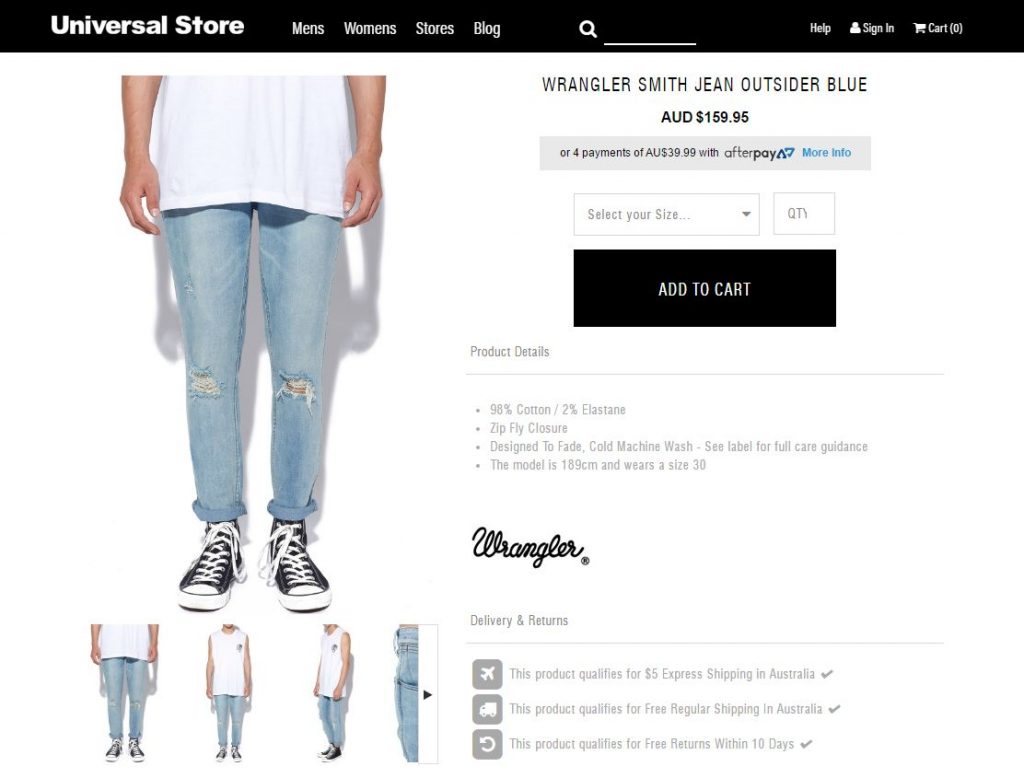
For some reason, Universal Store chooses to ignore it.
You can spend hours browsing a certain brand (Wrangler in this case) but almost never see Wrangler products in the recommendations:

Not a single recommendation is showing an item by Wrangler.
That is strange as the product catalog features a whole selection of Wrangler items. What stopped the store from including individual brand preferences into computations remains a mystery.
Correct Approach to Personalization
In Apparel and Accessories, Progressive Personalization uses three key parameters: gender, size, and individual brand preferences.
Gender and Brand Preferences
For instance, product recommendations for a pair women’s Nike sneakers at 6PM online store are shaped according to the visitor’s gender and brand preferences:
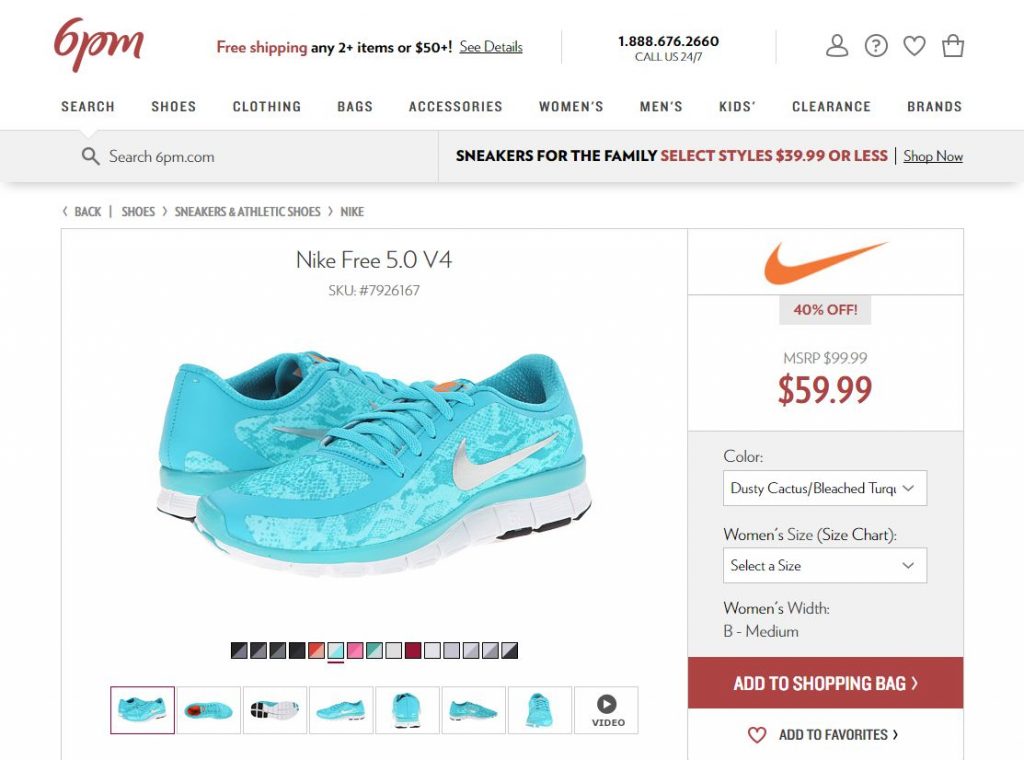

To the visitor viewing a pair women’s running shoes by Nike, the recommendations show more options from the same brand.
As discussed earlier, brand preferences can be shifted and including other brands in recommendations is a standard practice given that these form the minority of all product recommendations. ASOS demonstrates an excellent example of this principle:

Their recommendation block contains twelve thumbnails. The first eight thumbnails feature the same brand as the primary product.

The last four can feature alternative brands – given that they are placed on the third, least-viewed, page of the image slider.
Another interesting case is that of Ingrid & Isabel fashion store for pregnant ladies. Not only does it include into computation the visitor’s size but also the current trimester. Obviously, there is a significant difference in the clothes for women in their first trimester and the third one.
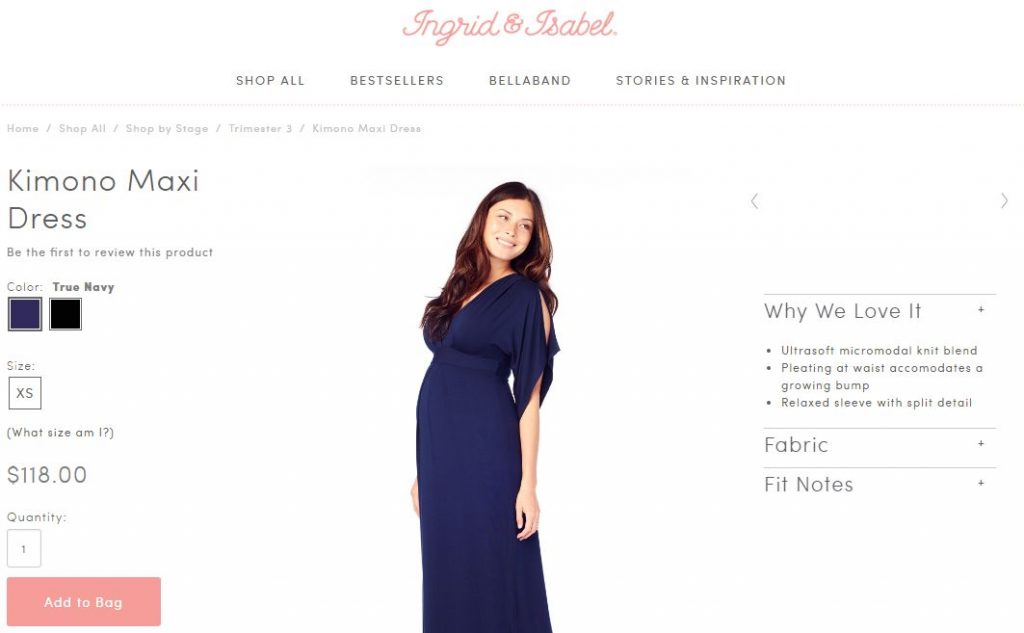
The visitor, browsing XS-sized items for expectant mothers on their third trimester, sees only the relevant items.
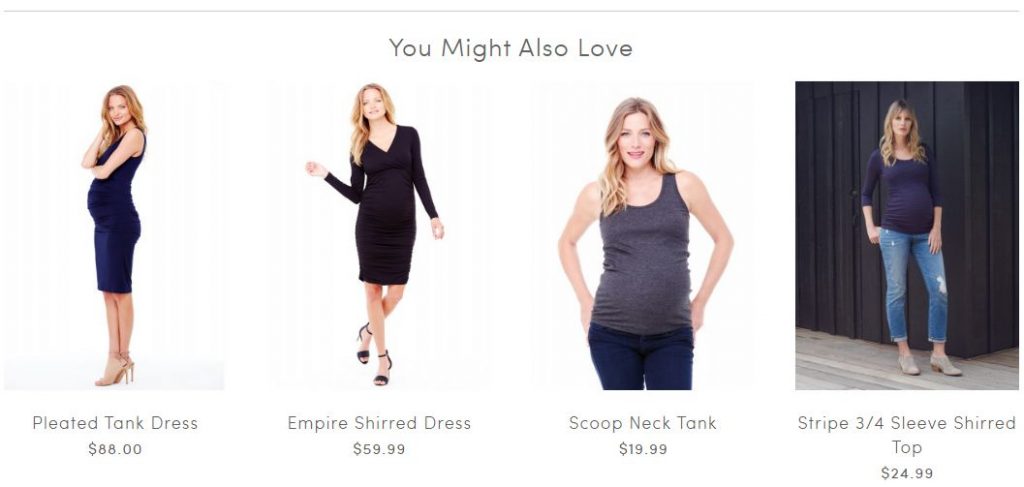
Each recommended item is designed for a third-trimester pregnant wearer, and each is available in XS size.
Personalization at Ingrid & Isabel is based on the REES46 Niche Solution designed specifically for Apparel & Accessories stores.
Principles of Progressive Personalization
Progressive Personalization relies on real-time customer behavior analysis including browsing history, “Add to Cart” clicks and purchase history. In 95% of instances, it gives a reliable, transparent insight, which the recommendation engine can use for the gender, size and brand preferences computations. A Progressive Personalization-driven recommendation engine applies detailed personalization to the product recommendations, unlike Big Data-based approaches.
Another advantage of this technology is its ethical methods of collecting personal data. Using Progressive Personalization, you never have to invade the personal space of your visitors the way Big Data requires you to. To draw a comparison, Big Data is essentially a like a big marketplace where data about you is resold to the other players. Everybody knows everything – from your shoe size to the food mix brand your feed your cat.
A recommendation engine with Progressive Personalization collects only the information that the visitor is willingly giving – such as clicks, purchase and pre-purchase events. This forms the basis of the highly relevant recommendations to each given prospect. This information is not a marketable commodity to resell but an instrument to help visitors find what they are looking for, right here and right now.
To clarify the principles, we’re providing you with the mechanics behind the technology.
Underlying Mechanics
Big Data-based personalization is a typical “black box.” You put the data in; something goes on in there, and, after a lengthy wait time, recommendation blocks start showing recommended products. Why these products? What parameters was the system guided by? Everybody’s reluctant to answer these questions.
Unlike the Big Data approach, which needs lengthy data collection and complex computations, the mechanics of Progressive Personalization are so clear that they can be explained in simple Excel tables. These examples are based on the three key parameters in Apparel & Accessories: visitor’s gender, clothing and shoe size, and brand preferences.
Gender
Progressive Personalization rule: the majority of all male customers buys men’s and unisex clothing, female — women’s and unisex. It’s a rare occasion that the clients buy clothing targeted at the other gender. Recommended products should correspond to the gender.
Consider this situation: A visitor comes to your online store for the first time and starts browsing your product catalog. In Apparel and Accessories, most of the items are gender-specific, and this is going to be the marker to help you only to recommend suitable items.
The first step is to prepare your catalog for Progressive Personalization – mark your products according to the customer’s gender:
| PRODUCT | GENDER TARGETING |
| Denzil ike jacket | Men’s |
| Lenox gloves | Women’s |
| Teddy B boots | Women’s |
| Re-port T-shirt | Unisex |
| Emeraldine bikini | Women’s |
| Chester pants | Men’s |
The next step is to trace the visitor’s browsing history to determine what product pages this person views. Tracing::
| VISITOR | BROWSED PRODUCTS |
| #001 | Men’s |
| Women’s | |
| Men’s | |
| Men’s | |
| Women’s | |
| Unisex | |
| Men’s | |
| Men’s | |
| Men’s | |
| Unisex |
Simple calculations show that visitor #001 browsed 10 product pages, out of which 6 featured men’s products; 2, women’s; and 2, unisex. The last (unisex) is not important for determining a visitor’s gender. In summary:
| Men’s | 6 |
| Women’s | 2 |
Determining the visitor’s gender based on their browsing history, there is 75% probability that this person is a man.
| Probability it is a man | 6 |
| Probability it is a woman | 2 |
| Gender | Male |
The recommended probability level for the algorithms to determine the gender is 75%. As long as it’s lower, the algorithms require more behavioral data.
In practical terms, it means that Progressive Personalization determines the gender after the first few visitor actions and will show suitable recommendations right from the start.
Besides the browsing history, the pre-purchase and purchase history are also available. This improves the model and brings a higher level of precision.
The browsing history may not suffice in a real situation – for instance; a man could have viewed a few women’s products out of mere curiosity – so it is better to rely on browsing, pre-purchase history, and purchase history combined. As the final two are closer to the purchase, it is evident that they hold more value.
Now the event map looks like this:
| PRODUCT | VIEW | CART | PURCHASE |
| Denzil ike coat | Men’s | ||
| Lenox gloves | Women’s | ||
| Teddy B boots | Women’s | ||
| WestShore purse | Women’s | ||
| Emeraldine bikini | Women’s | ||
| Chester pants | Women’s | ||
| Thunder Belt | Men’s | ||
| Sparrow hat | Men’s | ||
| Re-port T-shirt | – |
Every type of action has its weight. In REES46, we deduced the following correlation:
| View | 1 |
| Cart | 5 |
| Purchase | 10 |
One purchase tells you more about the visitor than 9 product views.
Let us now refresh the calculations based on this correlation.
A male marker scores two from browsing events and five from pre-purchase events (adding the hat to the cart). A female marker scores one from browsing events, 15 from pre-purchase events, and ten from the purchase.
| Men’s | 7 |
| Women’s | 26 |
| Probability it is a man | 21.21% |
| Probability it is a woman | 78.79% |
| Gender | Female |
Calculations tell us there is 78.79% probability this visitor is a woman. Now the algorithms will recommend women’s products, ensuring that these are going to be products the customer can afford and will be interested in.
In this example, we showed how Progressive Personalization helps determine a visitor’s gender. In practice, though, gender is not the only critical parameter in Apparel and Accessories. It is time to discuss the next parameter: size.
Size
Progressive Personalization rule: The majority of all customers buy clothes and shoes for personal use, and the correct sizing is a key purchase factor. Recommended products should correspond in size and also be available in stock.
Similar mechanics are used in clothing and shoe size calculations.
In the situation where different sizes of the same model are presented in your product catalog as separate lots, you can simply count browsing events in relation to each lot. However, the regular practice of using the SKU system makes this case a very rare one. When all the sizes are presented in a drop-down list or a tick list on the product page, tracking visitor’s actions is harder, as choosing a size is logically a step towards adding the item to the cart.
In both cases mechanics can be explained by the following table:
| BROWSED PRODUCTS (SHOES) | SIZE | |||||
| 38 | 39 | 40 | 41.5 | 42 | 42.5 | |
| SKU #001 | 1 | 1 | 1 | |||
| SKU #002 | 1 | 1 | 1 | |||
| SKU #003 | 1 | 1 | 1 | 1 | ||
| SKU #004 | 1 | 1 | 1 | 1 | ||
| SKU #005 | 1 | 1 | ||||
| SKU #006 | 1 | 1 | ||||
| SKU #007 | 1 | 1 | ||||
| SKU #008 | 1 | 1 | 1 | 1 | ||
| SKU #009 | 1 | 1 | 1 | |||
| SKU #010 | 1 | 1 | 1 | |||
| Frequency of occurrence | 3 | 7 | 8 | 5 | 2 | 2 |
| Probable size | YES | YES | ||||
Based on the total number of views, you can calculate the visitor’s probable shoe size.
If available, purchasing history should also be included in the calculations, as one purchasing event outweighs several browsing ones.
Brand Preferences
Progressive Personalization rule: A proportion of all customers form a strong liking for a certain brand and tend to stick to it while shopping. Recommended products should correspond to the brand preferences.
The last key parameter is brand preferences.
The most suitable mechanics are the advanced ones from the gender recognition example. First, we calculate the number of browsing, pre-purchase and purchase events:
| ITEM | BRAND | VIEW | CART | PURCHASE |
| Jacket | Zara | 1 | ||
| Jacket | Zara | 1 | ||
| Winter coat | H&M | 1 | ||
| Pants | Zara | 1 | ||
| Pants | TopShop | 1 |
Now the event-correlation scheme is applied:
| EVENT | SCORE |
| Browse | 1 |
| Cart | 5 |
| Purchase | 10 |
Based on that, you can deduce probable brand preferences:
| BRAND | SCORE |
| Zara | 16 |
| H&M | 1 |
| TopShop | 1 |
Conclusion — this visitor has the affinity for Zara products.
In Conclusion
Progressive Personalization allows supreme targeting level recommendations in Apparel & Accessories online stores, including into the computations such key parameters as a visitor’s gender, size and brand preferences. This is the latest trend in the industry, a trend that complements well another modern approach – Big Data. Unlike the latter, Progressive Personalization is successfully implemented and used by middle-sized online retailers that don’t yet generate enough traffic to use the Big Data approach effectively.